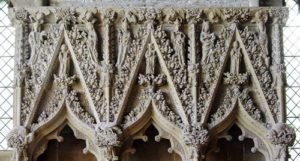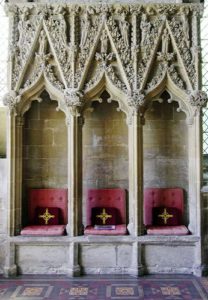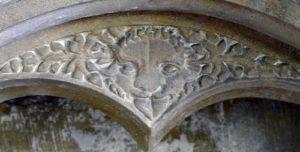Hawton is a small village south of Newark off the A46. The Church features in Jenkin’s “England’s Thousand Best Churches” with 3* for its Easter Sepulchre. We had tried to visit earlier in the year but found the church locked and the keyholder out. As one of the churches featured in Nottingham churches Open Weekend, this seemed too good an opportunity to miss, especially as knowledgeable parishioners were giving guided talks of the church.
Set in a graveyard with a VR postbox next to the gate, this is a lovely church. It has a splendid square tower with a carved stone frieze around the top and eight tall pinnacles. At the corners are carved stone gargoyles. The nave and side aisles are battlemented and buttressed. The church is 13thC and the chancel was built 14thC either by, or in the memory of, Sir Robert Compton whose tomb lies there. The nave clerestory and tower are 15thC, paid for by Sir Thomas Molyneaux. His shield is above the west doorway and also on a shield held by a small angel on a plinth near the organ. The porch is 19thC replacing an earlier one, with the carved head of a king and queen on either side of the doorway.
There are more carved heads on the outside of the windows. Don’t miss the mason above the south door of the chancel or the woman with tooth ache and a man pulling a face on the window to the left of it. On a wall buttress is a small mass sundial, scratched round a central hole. This was important before the days of clocks as it was used to tell the times of mass and other services.
Compared with the glories of the chancel, the nave is plain. Octagonal pillars with pointed arches separate nave and side aisles. There are small carved heads where the arches join and the arches on the north side are carved. The line of the original roof can be seen above the chancel arch. There is a wooden roof with carved bosses, including one with a Molyneux cross in the north aisle. At the end of the north aisle is a small organ. At the top of the window above it is the only fragment of medieval glass left in the church.
The rood screen separating nave and chancel dates from about 1500. It has wood panel bases with open carved arches above. The chancel floor is covered with patterned encaustic tile. At the east end under a plain glass window is a simple altar. At the base of all the windows are small carvings of the heads of Kings and Queens.
To the left is the glorious 14thC Easter Sepulchre, which is one of the best in England. This had been covered with layers of plaster and whitewash, possibly to protect them from Puritan damage. They were only discovered during the 19thC restoration of the church. In the centre is the tomb of Sir Robert de Compton. An ornate doorway on the left probably led into a long gone vestry or chapel. On the right is the Sepulchre itself. All have the most amazing carving round them with oak leaves, acorns and tiny heads and figures. The more you look the more you discover.
The doorway has tall narrow pillars with carved capitals. on either side of the base of the arch is the head of a King and Queen. A series of ogee arches with oak leaf and acorn carving on the outer edge terminate at a finial with a small carving of a bishop.
The tomb of Sir Robert de Compton is on the floor in an arched recess with a man and woman’s head at the base with carvings up the sides. On the top of is a badly worn figure of a bishop. On the inside of the arch are two figures with a book in their hands and also a green man. On the back wall is the remains of a hagioscope (squint) to allow people in the vestry or chapel to see what was happening at the high altar.
Sir Robert is dressed in chain mail with a sword and shield. The shield is next to the wall, suggesting the tomb has been moved here from elsewhere.
To the right is the Easter Sepulchre. A small recessed niche in the back wall on the left received the consecrated Host on Good Friday until Easter morning. Very early, it was taken out accompanied by the singing of anthems and was carried to the high altar. Thus symbolising the death and resurrection of Christ.
This is set in an marvellously carved panel. Along the base in four arches are the carved figures of the sleeping soldiers, dressed in 13thC chain mail and holding their shields which have heads or dragons carved on them. Look carefully for all the tiny heads carved round the arches and the oak leaves and acorns.
Above, the figure of Jesus can be seen climbing out of the tomb with a wound in his side. Beside him are the three Marys and a kneeling angel. This is set in three highly decorated arches with animals at the corners and more oak leaves and acorns.
At the top of the centre arch, surrounded by oak leaves are his feet and a single footprint, representing the Ascention into Heaven. On either side are the carved figures of the eleven disciples and Mary, the only one wearing shoes. Above are angels holding banners.
On the opposite wall is a three seat sedilia where the celebrant, deacon and sub deacon sat during mass, set under three equally beautiful carved arches. Again these repay close examination as the level of detail is amazing. At the base of one of the arches is a bird of prey (meant to be a pelican, but perhaps the medieval carver didn’t know what a pelican looked like) plucking its breast to feed its young. This is a common Christian symbol representing Christ shedding his blood for us. Next to it are two youths cutting grapes symbolising the wine used in the Eucharist.
Above the arches are carved figures. In the centre is St Edmund holding an arrow, a symbol of his martyrdom. On either side are two unidentified bishops. Above them are five saints being crowned by angels. These have been identified from the left as St Anne, mother of the Virgin Mary, St Catherine, St Clement martyr with an anchor as he was thrown into the Caspian sea, St Peter with his keys and Margaret of Antioch with a dragon at her feet.
To the left is a double piscina. One side was used for washing the communion vessels, the other the priest’s hands. This dates from 1300-1330 and is set in a double arch under a single arch. On either side are carvings of a musician. There are carvings of leaves and on the top a leafy finial.
This is a beautiful church and a very well worth while visit. Visit website.










